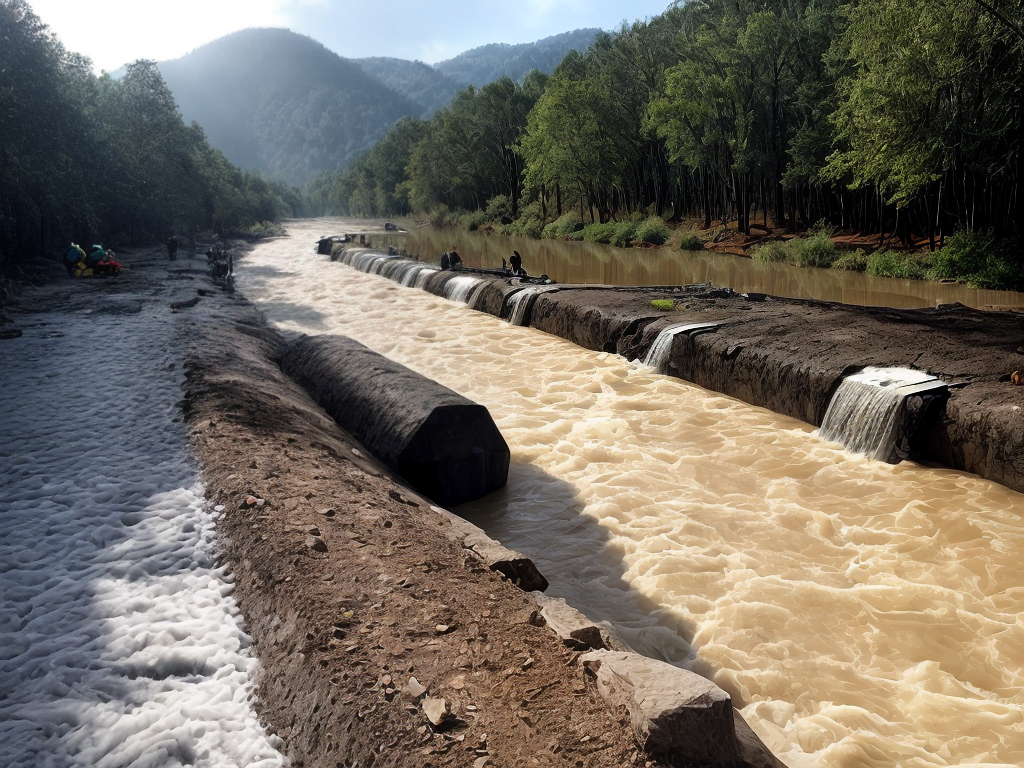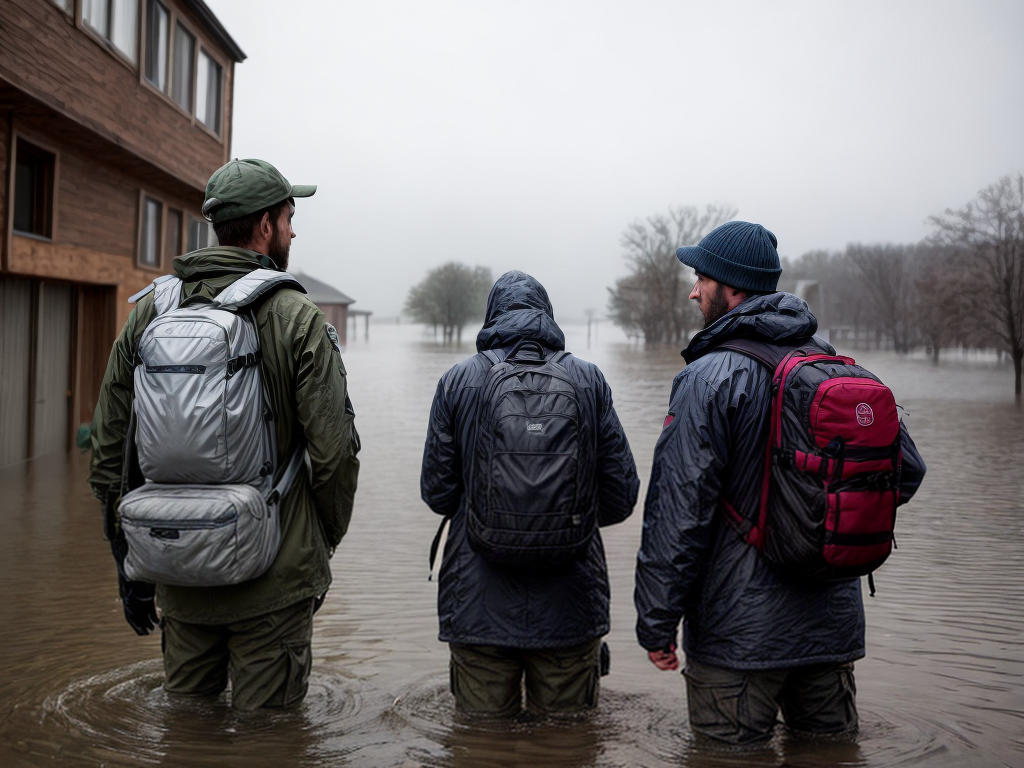So, you’re living in a flood-prone community and you think you’re prepared, huh? Well, buckle up, because there’s a lot more to it than you might think. In this discussion, we’ll explore the essential steps you need to take to ensure your community is well-prepared for flood emergencies. From understanding the risks to creating a communication network and developing a recovery plan, this comprehensive guide will equip you with the knowledge and tools to tackle any flood situation. But trust us, it’s not as simple as just having a few sandbags ready. So, let’s dive in and uncover the key strategies for community preparedness that will leave you feeling confident and ready for whatever Mother Nature throws your way.
Key Takeaways
- Understanding the geographic and hydrological factors contributing to flooding is crucial in assessing flood risks and vulnerability.
- Establishing a Community Emergency Response Team (CERT) and providing comprehensive training for team members is essential for effective response and coordination during flood emergencies.
- Developing an evacuation plan and communication network that includes safe meeting locations, emergency contact information, and multiple communication channels is vital for ensuring the safety of community members during floods.
- Educating community members on flood preparedness through workshops, online resources, and tailored information, as well as stocking emergency supplies including water purification devices and non-perishable food items, are important for increasing community resilience and readiness in flood emergencies.
Understand Flood Risks
To better prepare for flood emergencies, it is crucial that we thoroughly understand the risks associated with flooding. In order to develop effective strategies for flood prevention and mitigation, we need to have a comprehensive understanding of the potential dangers that floods can pose to our communities and infrastructure.
One of the key aspects of understanding flood risks is to analyze the geographic and hydrological factors that contribute to flooding. By studying the topography, soil composition, and rainfall patterns of our area, we can identify vulnerable areas that are more prone to flooding. This knowledge allows us to prioritize our efforts in implementing flood prevention measures in these high-risk zones.
Additionally, understanding the impact of floods on our infrastructure is vital for effective flood mitigation strategies. We need to assess the vulnerability of critical infrastructure such as roads, bridges, and buildings to flood damage. By identifying weak points and developing solutions to strengthen these structures, we can minimize the disruption caused by floods and ensure the safety of our communities.
Furthermore, a thorough understanding of flood risks enables us to innovate and explore new technologies and approaches for flood prevention and mitigation. By staying informed about the latest advancements in flood control systems, early warning systems, and sustainable drainage solutions, we can continuously improve our ability to manage flood emergencies and protect our communities.
Establish a Community Emergency Response Team
Now let’s talk about how to establish a Community Emergency Response Team (CERT) to effectively respond to flood emergencies. The first step in the team formation process is identifying and recruiting volunteers from the community who are willing to contribute their time and skills. Once the team is formed, it is crucial to provide them with comprehensive training and ensure proper coordination among team members to ensure a swift and efficient response during flood emergencies.
Team Formation Process
Our first step in establishing a Community Emergency Response Team is to gather a group of dedicated individuals who are willing to contribute their time and skills to help our community prepare for flood emergencies. To ensure a successful team, we need to focus on team-building activities and effective communication. Here’s how we can achieve this:
- Encourage collaboration: Foster a sense of unity and cooperation among team members through team building exercises. These activities will help build trust and camaraderie, enabling the team to work together more effectively during emergencies.
- Develop communication skills: Effective communication is crucial for a well-coordinated response. Provide training sessions that focus on clear and concise communication, active listening, and problem-solving. This will ensure that information is conveyed accurately and quickly, enhancing the team’s ability to respond efficiently in high-stress situations.
- Embrace innovation: Encourage team members to think creatively and find innovative solutions to challenges. Foster an environment where ideas are welcomed, and individuals are empowered to take initiative. This will enable the team to adapt and respond effectively to unforeseen circumstances, ensuring the best possible outcomes for our community during flood emergencies.
Training and Coordination
We will now discuss the training and coordination necessary to establish a Community Emergency Response Team. To ensure the effectiveness of the training, it is crucial to engage the community in the process. By involving community members in the training, we can tap into their local knowledge and expertise, fostering a sense of ownership and empowerment. This approach promotes innovation and encourages the sharing of ideas and best practices. Furthermore, community engagement helps to build trust and strengthen relationships among team members, enhancing coordination during flood emergencies. Effective training programs should incorporate a variety of interactive and hands-on exercises, allowing participants to develop practical skills and build confidence. By investing in comprehensive training and fostering community engagement, we can establish a capable and resilient Community Emergency Response Team ready to face the challenges of flood emergencies.
Develop an Evacuation Plan
Let’s talk about the important points to consider when developing an evacuation plan for flood emergencies. First, we need to identify safe meeting locations where everyone can gather and stay out of harm’s way. Second, it is crucial to have a list of emergency contact information readily available, including local authorities and family members. Lastly, we must create an essential supplies checklist to ensure that we have everything we need to sustain ourselves during the evacuation period.
Safe Meeting Locations
Selecting designated safe meeting locations is crucial when developing an evacuation plan for flood emergencies. These locations serve as gathering points for individuals and families to reunite and ensure everyone’s safety. To ensure innovation in your evacuation plan, consider the following three factors when choosing safe meeting locations:
- Proximity to Emergency Protocols: Select meeting locations that are close to emergency response centers or designated evacuation shelters. This will enable quick access to medical assistance and necessary supplies.
- Accessibility to Evacuation Routes: Choose meeting locations that are easily accessible from different parts of the community. This will ensure that everyone can reach the location quickly and safely, regardless of their location during the flood emergency.
- High Ground or Elevated Areas: Opt for meeting locations that are situated on higher ground or elevated areas. This reduces the risk of being affected by floodwaters and provides a safer environment for individuals and families to gather.
Emergency Contact Information
When developing an evacuation plan for flood emergencies, it is essential to establish clear and accessible emergency contact information. Effective emergency communication is crucial in ensuring the safety and well-being of individuals during such challenging situations. To foster innovation in emergency preparedness, it is recommended to utilize modern technologies and platforms for emergency contacts. Instead of relying solely on traditional phone calls, consider incorporating text messaging, social media, and other digital platforms as alternative means of communication during emergencies. This approach can help disseminate information quickly and efficiently, reaching a larger audience in a shorter period. Additionally, it is important to regularly update and review emergency contact information to ensure its accuracy. By adopting innovative methods and staying proactive, communities can enhance their ability to respond effectively to flood emergencies and protect their residents.
Essential Supplies Checklist
To ensure preparedness for flood emergencies, it is essential to have an evacuation plan in place, which includes an essential supplies checklist. This checklist is crucial for ensuring that you have all the necessary items to sustain yourself and your family during an emergency. Here are three innovative items to include in your stockpile checklist for optimal emergency preparedness:
- Water purification system: Investing in a portable water purifier can provide you with clean drinking water even when the regular supply is contaminated. Look for advanced filtration methods like UV or activated carbon filters for maximum effectiveness.
- Solar-powered charger: In a flood emergency, power outages are common. Having a solar-powered charger for your electronic devices can keep you connected and informed during the crisis. Opt for a charger that is lightweight, durable, and can charge multiple devices simultaneously.
- Emergency food supply: Stock up on nutrient-dense, non-perishable food items that require little to no preparation. Look for options that have a long shelf life and provide a balanced mix of protein, carbohydrates, and essential vitamins and minerals.
Identify Safe Shelter Locations
We can identify safe shelter locations by thoroughly assessing the area and considering factors such as elevation, accessibility, and structural stability. When it comes to planning for flood emergencies, it is crucial to have safe shelter options in place to ensure the well-being and safety of the affected community. In our quest for innovation, we must think beyond traditional emergency housing and explore new approaches to providing secure and reliable shelter during floods.
One innovative solution is to identify high-elevation areas within the community that are less likely to be affected by flooding. These elevated locations can serve as safe havens for residents, providing a refuge from the rising waters. Additionally, by leveraging technology, we can create real-time flood mapping systems that help identify areas prone to flooding. This information can guide the selection of safe shelter locations and ensure that emergency housing is strategically placed.
Accessibility is another crucial factor to consider when identifying safe shelter locations. In flood emergencies, it is essential to have shelters that are easily accessible to everyone, including individuals with disabilities and the elderly. By prioritizing accessibility, we can ensure that no one is left behind during evacuation efforts.
Structural stability is paramount when selecting safe shelter locations. We must assess the structural integrity of buildings and facilities to ensure they can withstand the impact of a flood. In addition, the use of modular and prefabricated structures can provide quick and efficient emergency housing solutions that are both safe and cost-effective.
Create a Communication Network
After identifying safe shelter locations, our next step is to establish a robust communication network to ensure effective coordination and dissemination of information during flood emergencies. Creating a communication plan is crucial to stay connected and informed during such critical times. Here’s how we can establish a strong communication network:
- Designate Emergency Contacts: Assign specific individuals or teams who will be responsible for communication during a flood emergency. These contacts should be easily reachable and have the necessary tools and skills to disseminate information quickly and efficiently. Consider including representatives from local authorities, community organizations, and emergency response teams.
- Utilize Multiple Communication Channels: Relying on a single communication channel may not be sufficient during a flood emergency. It is vital to diversify and utilize multiple channels to ensure information reaches everyone promptly. This can include text messages, phone calls, social media platforms, emergency alert systems, and community websites. By using various channels, we can reach a wider audience and accommodate different communication preferences.
- Establish a Communication Hierarchy: In situations where communication may be limited or disrupted, it is essential to establish a clear hierarchy of communication. This hierarchy should outline who communicates with whom, ensuring that information flows smoothly and efficiently. Having a structured communication hierarchy will prevent confusion and delays in critical decision-making processes.
Educate Community Members on Flood Preparedness
One crucial step in preparing for flood emergencies is educating community members on flood preparedness. By providing the right knowledge and skills, we can empower individuals to respond effectively in times of crisis. Community engagement is key in ensuring that everyone understands their roles and responsibilities in flood response.
To engage the community, it is important to use innovative and interactive methods of education. A great way to accomplish this is by organizing workshops and training sessions that focus on flood preparedness. These sessions can cover topics such as the importance of early warning systems, evacuation procedures, and emergency communication protocols.
To further enhance community engagement, we can also utilize technology and digital platforms. For instance, we can create online resources and interactive tools that provide information on flood preparedness. These resources can be easily accessible to community members, allowing them to educate themselves at their own pace. Additionally, we can develop mobile applications that provide real-time updates on flood alerts and evacuation routes, ensuring that community members stay informed and prepared.
To effectively educate community members, it is essential to tailor the information to their specific needs. By conducting surveys or focus groups, we can gather insights into the knowledge gaps and concerns of the community. This valuable feedback can then be used to develop targeted educational materials that address these specific needs.
Stock Emergency Supplies
To ensure preparedness for flood emergencies, it is essential to stock emergency supplies. During such situations, having the right supplies readily available can significantly improve our ability to handle the challenges that arise. Here are three key items to include in your emergency kit:
- Water purification devices: Traditional methods of purifying water may not be available during a flood emergency. Therefore, it is crucial to have water purification devices that can provide safe drinking water. Innovative solutions like portable water filters or purifying tablets can be a game-changer in such situations, ensuring you have access to clean water.
- Solar-powered chargers: In today’s digital age, staying connected is essential, even during emergencies. Having solar-powered chargers for your electronic devices can help ensure you can stay connected with loved ones and access important information. These chargers harness the power of the sun to keep your devices charged, providing an innovative and sustainable solution.
- Emergency food supplies: During a flood emergency, access to food may be limited. It is important to have a stock of non-perishable food items that can sustain you for an extended period. Consider innovative options like freeze-dried meals or meal replacement bars, which offer convenience and long shelf life.
When it comes to emergency supplies procurement, it is crucial to think outside the box and seek innovative solutions that can enhance our preparedness. By incorporating items like water purification devices, solar-powered chargers, and emergency food supplies into our emergency kits, we can be better equipped to handle flood emergencies with efficiency and resilience.
Secure Important Documents and Valuables
Now let’s talk about how to protect our important documents and valuables during a flood emergency. We need to come up with strategies to keep our documents safe and secure, such as using waterproof containers or storing them digitally. Additionally, we should consider the best way to store our valuable items to prevent damage or loss.
Document Protection Strategies
We can ensure the safety of our important documents and valuables during flood emergencies by implementing effective document protection strategies. Here are three innovative strategies to protect your documents and valuables:
- Document Organization: Create a system for organizing your important documents digitally. Scan and save them in a secure cloud storage platform, ensuring easy access even if physical copies are damaged. Categorize and label each document for quick retrieval.
- Data Backup: Regularly back up your digital files to multiple locations, such as external hard drives or online backup services. This redundancy will safeguard your documents in case one backup fails. Consider using automated backup software to simplify the process.
- Waterproof Storage: Invest in waterproof and fireproof storage containers or safes to protect physical documents and valuables. These containers will provide an extra layer of protection during flood emergencies, keeping your items safe from water damage.
Valuable Item Storage
Implementing effective document protection strategies is crucial for ensuring the safety of our valuable items, including important documents, during flood emergencies. While having an emergency kit is essential, it’s equally important to consider hidden storage options to safeguard our valuables. These hidden storage solutions not only provide security but also add a touch of innovation to our preparedness plan. Check out the table below for some innovative hidden storage ideas that can be incorporated into your emergency kit:
| Hidden Storage Ideas | Benefits |
|---|---|
| Waterproof document bags | Protects important documents from water damage |
| Diversion safes | Camouflages valuable items by hiding them in plain sight |
| Portable safes | Provides secure storage for important documents and small valuables |
Implement Flood Warning Systems
To effectively prepare for flood emergencies, it is crucial to establish and utilize flood warning systems. These systems play a vital role in providing early warnings and ensuring the safety of communities at risk. Here are three innovative ways in which flood warning systems can be implemented:
- Advanced Flood Monitoring Technology: By leveraging cutting-edge technology such as remote sensing, satellite imagery, and real-time data collection, flood monitoring can be significantly enhanced. These advanced systems can detect changes in water levels, rainfall patterns, and river conditions, providing timely and accurate information for early warning systems.
- Integrated Sensor Networks: Implementing a network of sensors throughout flood-prone areas can help monitor water levels, rainfall intensity, and soil moisture content. These sensors can transmit data in real-time, allowing authorities to monitor flood conditions and issue timely warnings to residents. Additionally, integrating these sensor networks with weather forecasting models can improve the accuracy of flood predictions.
- Mobile Applications and Alerts: Developing mobile applications and alert systems can help disseminate flood warnings to a wider audience. These applications can provide real-time updates, evacuation routes, and emergency contact information. By utilizing push notifications and SMS alerts, residents can receive timely warnings directly to their smartphones, enabling them to take necessary precautions and evacuate if required.
Coordinate With Local Authorities and Emergency Services
Once flood warning systems are in place, the next step in planning for flood emergencies is to coordinate with local authorities and emergency services. It is crucial to establish effective communication channels and partnerships with these organizations to ensure a coordinated and efficient response during flood emergencies. By coordinating with local organizations and engaging community members, we can enhance our preparedness and response efforts, leading to better outcomes and quicker recovery.
Coordinating with local authorities and emergency services involves establishing clear lines of communication and sharing important information. It is vital to establish a strong working relationship with these organizations, as they have the expertise and resources needed to respond effectively to flood emergencies. By coordinating our efforts, we can avoid duplication of services, maximize available resources, and streamline response efforts.
Engaging community members in the planning process is equally important. By involving the community, we can tap into their knowledge, skills, and resources. This can include organizing community meetings, creating volunteer initiatives, and conducting training sessions to equip community members with the necessary skills to respond to flood emergencies. By engaging the community, we empower them to take an active role in their safety and resilience.
Coordination with local authorities and emergency services also allows for a more comprehensive approach to flood emergency planning. By working together, we can identify vulnerable areas, develop evacuation plans, and establish emergency shelters. This collaborative approach ensures that all aspects of flood emergency preparedness and response are considered, leading to a more effective and efficient response.
Conduct Regular Drills and Exercises
Let’s talk about the importance of conducting regular drills and exercises when it comes to preparing for flood emergencies. Simulation-based training and mock evacuation drills can help us familiarize ourselves with emergency protocols, identify areas for improvement, and enhance our response capabilities. By practicing various scenarios and testing our preparedness, we can ensure that we are ready to effectively handle any flood emergency that may arise.
Simulation-Based Training
Regular drills and exercises are essential for simulation-based training to effectively prepare for flood emergencies. By utilizing virtual reality training, communities can reap numerous benefits.
- Benefits of virtual reality training: Virtual reality allows individuals to experience realistic scenarios without the inherent risks. This immersive technology enhances situational awareness, decision-making skills, and response time. It also provides an opportunity for repetitive practice, which helps build muscle memory and confidence in handling emergencies.
- Role of simulations in disaster preparedness: Simulations play a crucial role in disaster preparedness by providing a safe environment for training and assessment. They allow responders to practice coordination, communication, and resource management. Simulations also facilitate the evaluation of existing emergency plans and identify areas that require improvement.
Mock Evacuation Drills
Now let’s explore the importance of conducting regular drills and exercises, specifically focusing on mock evacuation drills, to enhance preparedness for flood emergencies. Mock evacuation drills play a crucial role in assessing the effectiveness of emergency plans and identifying areas for improvement. By simulating real-life scenarios, these drills allow communities to evaluate their response capabilities and identify any gaps in their preparedness strategies. Through these exercises, we can test the efficiency of evacuation routes, communication systems, and emergency shelters. It also provides an opportunity to evaluate the effectiveness of our flood risk assessment and response plans. By conducting regular mock evacuation drills, we can fine-tune our emergency preparedness, ensuring that our community is ready to respond quickly and efficiently in the face of a flood emergency.
Establish a System for Monitoring and Reporting Flood Conditions
We need to establish a reliable system for monitoring and reporting flood conditions. With the rapid advancements in monitoring technology, we have the opportunity to revolutionize our emergency response efforts. Here are three innovative ways we can enhance our monitoring and reporting capabilities:
- Remote Sensing Technology: By utilizing remote sensing technology such as satellite imagery, we can gather real-time data on flood conditions from a bird’s-eye view. This technology can provide us with crucial information on the extent of flooding, areas at high risk, and the rate at which water levels are rising. With this data, emergency responders can make informed decisions and allocate resources more effectively.
- Sensor Networks: Deploying an extensive network of sensors throughout flood-prone areas can provide us with accurate and up-to-date information on water levels, rainfall intensity, and weather conditions. These sensors can be installed in rivers, drainage systems, and key infrastructure points, allowing us to monitor flood conditions in real time. This data can be transmitted to a centralized command center, enabling emergency responders to quickly assess the situation and take immediate action.
- Crowdsourced Data: In addition to official monitoring systems, we can harness the power of crowdsourcing to gather valuable data from the community. Through mobile applications and social media platforms, residents can report flooding incidents, share photos and videos, and provide real-time updates on flood conditions in their area. This crowd-sourced information, when validated and integrated with official data, can help emergency responders gain a more comprehensive understanding of the flood situation and respond more efficiently.
Develop a Post-Flood Recovery Plan
To ensure a swift and effective recovery from flood damage, our focus must now shift towards developing a comprehensive post-flood recovery plan. This plan will outline the strategies and actions necessary for rehabilitation and rebuilding efforts in the aftermath of a flood. It is crucial to have a well-thought-out plan in place to minimize the impact of future floods and to expedite the recovery process.
A post-flood recovery plan should encompass various aspects, including infrastructure repair, community support, and economic revitalization. To illustrate the importance of this plan, let’s consider a table showcasing the key components of an effective post-flood recovery strategy:
| Post-Flood Recovery Strategies | Rehabilitation and Rebuilding Efforts |
|---|---|
| Assessing damage and needs | Repairing and rebuilding infrastructure |
| Providing emergency assistance | Restoring utilities and services |
| Resettling displaced residents | Enhancing community resilience |
By implementing these strategies, communities can recover more quickly and build back stronger after a flood. Assessing the damage and identifying the needs of affected areas is the first step in the recovery process. This information is crucial for allocating resources effectively and efficiently.
Emergency assistance, such as shelter, food, and medical aid, must be provided to those affected by the flood. This support helps ensure the safety and well-being of individuals and families during the recovery period.
Resettling displaced residents is another vital aspect of the recovery plan. Efforts should be made to find suitable housing for those who have lost their homes, allowing them to resume their lives as quickly as possible.
Additionally, restoring utilities and services is essential for the community’s functionality and recovery. Repairing and rebuilding infrastructure, such as roads, bridges, and public buildings, is crucial for ensuring the smooth functioning of daily life.
Lastly, enhancing community resilience is a long-term goal that involves implementing measures to mitigate the impact of future floods. This includes improving drainage systems, implementing flood-resistant building techniques, and educating residents about flood preparedness.
Promote Community Resilience and Support Networks
After addressing the immediate needs of flood-affected areas, the focus shifts towards promoting community resilience and establishing support networks. Community engagement and risk assessment play a crucial role in achieving these goals. Here are three innovative ways to promote community resilience and support networks:
- Foster a culture of collaboration: Encourage community members to actively participate in decision-making processes. By involving them in the planning and implementation of flood preparedness measures, we empower individuals to take ownership of their safety and well-being. This can be done through town hall meetings, workshops, and online platforms that allow for open dialogue and idea-sharing.
- Develop a network of community volunteers: Create a database of individuals willing to assist during emergencies. These volunteers can be trained in disaster response techniques, such as first aid and search and rescue, to provide immediate assistance in flood-affected areas. Establishing a strong network of volunteers ensures that support can be quickly mobilized when needed, enhancing the community’s resilience.
- Utilize technology for communication and coordination: Leverage digital tools to enhance communication and coordination among community members. This can include creating a dedicated mobile application or website for sharing real-time information, organizing community drills, and providing updates on evacuation routes and emergency services. By embracing technology, we can facilitate faster and more efficient communication during flood emergencies, ultimately bolstering community resilience.
Promoting community resilience and establishing support networks are essential for effective flood preparedness. By engaging the community, conducting risk assessments, and adopting innovative approaches, we can ensure that our communities are prepared, resilient, and capable of responding to flood emergencies.
Stay Informed and Updated on Flood Preparedness Best Practices
Staying informed and updated on flood preparedness best practices is crucial for ensuring the safety and well-being of communities at risk. In today’s fast-paced world, where information is constantly evolving, it is essential to have effective flood preparedness communication strategies in place. By staying informed, communities can proactively respond to potential flood emergencies and minimize the impact on their lives and properties.
One of the most effective ways to stay informed is through emergency response training. These training sessions provide community members with the necessary skills and knowledge to respond effectively during a flood emergency. They learn how to identify warning signs, assess risks, and take appropriate action to protect themselves and their loved ones. Emergency response training also equips individuals with the ability to assist others in their community, fostering a sense of unity and resilience.
Furthermore, leveraging technology can greatly enhance flood preparedness communication. Innovative tools such as mobile applications, social media platforms, and automated alert systems can provide real-time updates and notifications about potential flood risks. These platforms enable communities to receive critical information promptly and make informed decisions about evacuation or taking necessary precautions.
In addition, collaboration between local authorities, community organizations, and residents is essential for effective flood preparedness communication. By working together, they can share information, resources, and best practices, ensuring that everyone is on the same page when it comes to flood preparedness. This collaborative approach fosters a culture of resilience and encourages individuals to actively participate in their community’s flood preparedness efforts.















